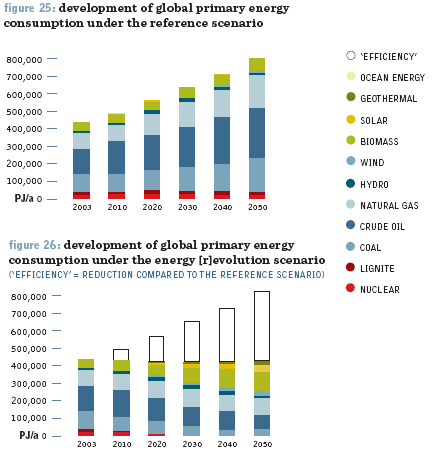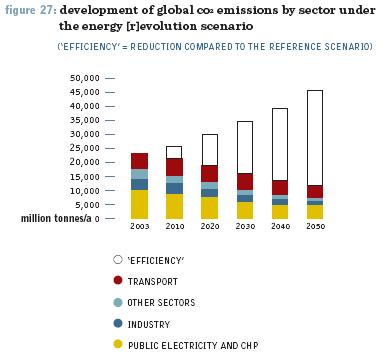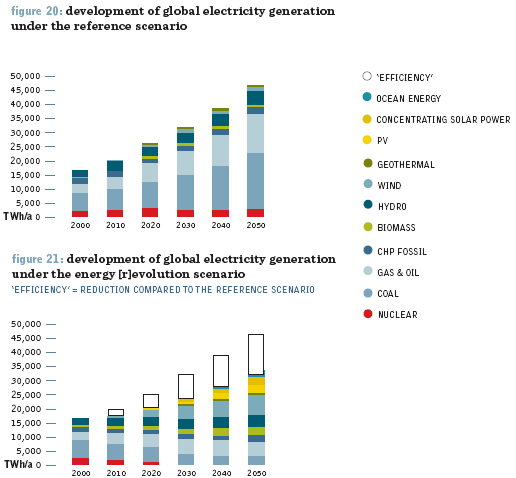
Investing in a renewable electricity future will save 10 times the fuel costs of a ‘business as usual’ fossil-fuelled scenario, saving $180 billion annually and cut CO2 emissions in half by 2030, according to a joint report by Greenpeace and the European Renewable Energy Council (EREC) released today. (download it here pdf) (1)
In the first global analysis of its kind, “Future Investment – A sustainable Investment Plan for the power sector to save the Climate”, demonstrates a powerful economic argument for a shift in global investments towards renewable energy (including solar, wind, hydro, geothermal and bio-energy), within the next 23 years. The report gives the financial rationale for Greenpeace’s “Energy [R]evolution,” a blueprint for how to cut global CO2 emissions by 50% by 2050, while maintaining global economic growth (download is here pdf) (2).

“As Live Earth mobilizes billions of people to take urgent action against the climate threat, our report shows not only that the world’s electricity needs can be met by renewable energy, but that by doing so, we will literally save trillions of dollars; a massive US $180 billion a year, forever†said Sven Teske, Greenpeace International, Energy Expert.
“In sharp contrast, a ‘business as usual’ approach casts a dark cloud over our future. Its 10,000 new fossil fuel power plants, would increase global CO2 emissions by over 50%, and more than double fuel costs; there is no way of putting a price on the disastrous results this will have for environment and humanity.â€
The Energy [R]evolution needs an extra global annual investment of $22 billion in clean and renewable power plants on top of current expenditure. The fuel cost savings in the scenario, of up to $202 billion per year, means this will pay for itself ten times over. Meanwhile, converting the massive subsidies of $250 billion a year that coal and gas receive to clean, safe renewable energy will cover the costs of the energy [r]evolution and much more.

According to EREC the global market for wind turbines was worth some €18 billion in 2006, and the total renewable industry $50 billion. Under an energy [r]evolution scenario, the renewable energy would be worth a massive $ 288 billion by 2030.
“The renewable industry is willing and able to deliver the power plants the world needs, we simply need the right climate and energy policy. Decisions made in the next few years, will continue to have an impact in 2050. Only if a renewable energy path is taken, can we avoid the worst excesses of climate change!†said Oliver Schäfer, EREC policy director.
The report stresses the urgent need for decisive action now. In the next decade, many existing power plants will need replacing,
and emerging economies such as China, India and Brazil are rapidly building new energy infrastructure.
Notes
1. The Energy [R]evolution Scenario is an alternative to the IEA´s world energy outlook, and a practical blueprint for how to cut global energy related CO2 emission by 50% by 2050 to avoid dangerous climate change, while maintaining global economic growth.
2 With no change in energy policy, utilities will invest in more than 10,000 new fossil fuel power plants until 2030 worldwide. To supply those coal and gas fired power plants with fuel will add up between today and 2030 to US$18,6 trillion,
compared to US$13,1 trillion in the Energy [R]evolution Scenario. This means fuel costs in the Energy [R]evolution Scenario are already 30% lower in the year 2030, by 2050, they are more than 70% lower.
Hello Naib,
Are your numbers on fuel cost saves based on nearly stable fossil fuels prices ?
Because all signs point to rapidly increasing fossil-fuel prices.
And figures like “50% increase in petrol use” are not very significative as long as we seem already close to the maximum output.
I mean we can increase gas or coal, not petrol consumption.
This means clean future is even better than GreenPeace say :-D